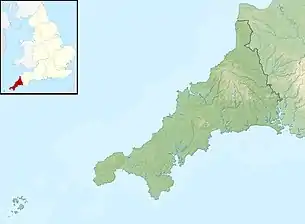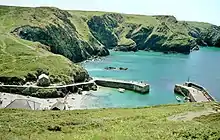Santo Christo de Castello
The Santo Christo de Castello was a mid‐17th century Genoese merchant ship sailing from Amsterdam that was wrecked on its maiden near Mullion Cove, Cornwall, England in 1667. In the late 17th and 18th centuries various efforts were made to recover the silver it was said to have carried. It was then forgotten, but was rediscovered in 1969, and interesting artifacts have been recovered.
| History | |
|---|---|
| Genoa | |
| Name | Santo Christo de Castello |
| In service | 1667 |
| Stricken | 3 October 1667 |
| Fate | Wrecked |
| General characteristics | |
| Class and type | Galleon (merchant vessel) |
| Armament | 48 guns |
First and last voyage
The Genoese galleon Santo Christo de Castello was sailing from Amsterdam to Genoa under Captain Lorenzo Vivano when it was wrecked. The ship was armed with 48 guns, some of which were bronze. She carried cloth, spices and a general cargo, including "piggs" of lead.[1] This was the ship's maiden voyage.[2]
Wreck

The Santo Christo de Costello was wrecked in a gale in October 1667 near the Lizard of Cornwall, England "between the growing and flowing back of the sea".[3] The vessel took shelter from gales in Mount's Bay on 5 October 1667. After lying at anchor for two days, on 7 October 1667 it was driven ashore at Mullion Cove. Most of the 120 people on board escaped in the ship's boats, but 25 were drowned. Probably the ship sheltered too close to the cliffs and was caught when the wind shifted direction.[2]
A document in Latin from shortly after the wreck authorizes the public sale by auction of what remained of the Sanctus Christus de Castello including her tackle and equipment, anchors, guns and ropes, goods, property, merchandise or objects of trade.[4]
Early salvage efforts
There is a wreck at Bumble Rock which is probably the Santo Christo de Castello.[5] The wreck is in a shallow cove near Polurrian, Mullion, Cornwall.[6] The ship had a lot of silver aboard, making it a target for divers ever since.[5] In the late 17th and 18th centuries the Bumble Rock wreck was often visited by divers.[7]
The London shipowner and merchant Philip Ford signed an agreement with King James II of England in September 1688 by which he could search for wrecks along the south coast of England and around the Isles of Scilly, paying 1/5 of the value to the King. He would pay another 1/5 to Sidney, Lord Godolphin, for treasure from ships owned by Godolphin found near the Isles of Scilly.[8] Ford found four piggs near the Lizard holding 3,310 ounces (94,000 g) of silver and paid the King's fifth. The Bishop of Exeter claimed half the profits in his role as Vice-Admiral of South Cornwall, but his claim was rejected. The silver may well have come from the 'Santo Christo de Castello.[7]
In the summer of 1732 the Eagle made a wreck-hunting voyage around the south of England.[5] The expedition reached the Lizard in June, where they began diving on the wreck of the Royal Anne Galley, a 40-gun man of war that had been wrecked on the Stagg Rocks in November 1721, and on the wreck at Bumble Rock, the main target. In five weeks of diving they recovered some minor objects of little value from the man of war, and recovered nothing from Bumble Rock but some ballast stones and a small piece of much-eroded iron.[9]
Recent findings

The wreck was rediscovered in 1969 by Peter McBride. He worked with Roy Davis and Richard Larn, founder of the Shipwreck Centre, to explore the wreck, retrieve artifacts and identify the wreck.[2] It became known as the "Mullion Pin Wreck" due to a large quantity of sewing pins that was found.[10] Later a fragment of the ship's bell revealed the identity as the Santo Christo de Costello.[2]
The divers found a sundial that fired a small cannon at a set hour and a brass statuette of a "tobacco boy".[2] Other artifacts included religious objects and the ship's armament.[11] The shipwreck contained "EB" clay tobacco pipes made by Eduard Bird (c. 1610–1665) of Amsterdam.[3] A double-side medallion with the images of the saints Francis of Assisi and Anthony of Padua was recovered.[12] In the summer of 1974 divers found a bronze statuette and a miniature bronze tobacco pipe from a matrix below one of the cannons.[3]
The Shipwreck Centre in Charlestown, Cornwall holds a collection of objects recovered from the wreck.[2] The National Maritime Museum in Greenwich, London has some of the brass and lead link shot.[6]
Notes
- Shipwreck, unique collection of 1667...
- Scholes 2018.
- Bradley & DeAngelo 1981, p. 111.
- McBride, Larn & Davis 1975, p. 237.
- Earle 2008, p. 233.
- KTP1091 link shot.
- Earle 2008, p. 89.
- Earle 2008, pp. 88–89.
- Earle 2008, p. 234.
- Larn 1981, p. 52.
- Abstracts in Anthropology 1976.
- Kingsley & Stemm 2013, p. 71.
Sources
- Abstracts in Anthropology, 1976, retrieved 15 July 2019
- Bradley, James W.; DeAngelo, Gordon (Fall 1981), "European Clay Pipe Marks from 17th Century Onondaga Iroquois Sites", Archaeology of Eastern North America, Eastern States Archeological Federation, 9: 109–133, JSTOR 40897742
- Earle, Peter (8 July 2008), Treasure Hunt: Shipwreck, Diving, and the Quest for Treasure in an Age of Heroes, St. Martin's Press, ISBN 978-1-4299-8661-8, retrieved 15 July 2019
- Kingsley, Sean A.; Stemm, Greg (30 April 2013), Oceans Odyssey 3. The Deep-Sea Tortugas Shipwreck, Straits of Florida: A Merchant Vessel from Spain's 1622 Tierra Firme Fleet, Oxbow Books, ISBN 978-1-78297-149-8
- KTP1091 link shot, National Maritime Museum, Greenwich, London, retrieved 14 July 2019
- Larn, Richard (1 January 1981), Shipwrecks of Great Britain and Ireland, David & Charles, ISBN 978-0-7153-7491-7, retrieved 15 July 2019
- McBride, P.; Larn, R.; Davis, R. (September 1975), "A mid‐17th century merchant ship found near Mullion Cove 3rd interim report on the Santo Christo de Castello, 1667", The International Journal of Nautical Archaeology and Underwater Exploration, The Nautical Archaeology Trust Ltd., 4 (2): 237–252, doi:10.1111/j.1095-9270.1975.tb00917.x
- Scholes, Daniel (23 October 2018), "The History Behind Some Of Cornwall's Most Renowned Shipwrecks", Cornwall Life, retrieved 15 July 2019
- "Shipwreck, unique collection of 1667 brass artifacts from Amsterdam", eBay, Charlestown Shipwreck Centre, retrieved 14 July 2019